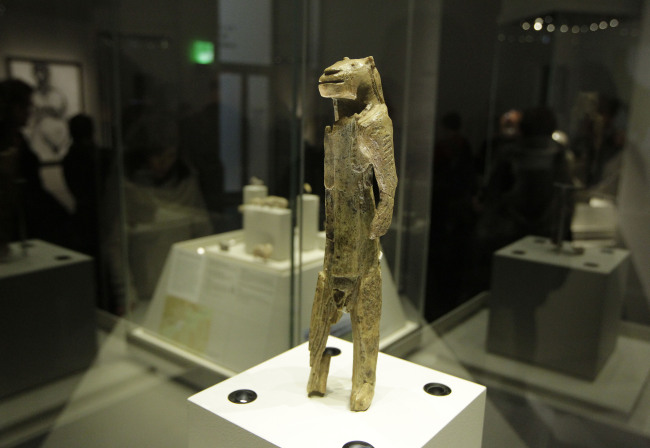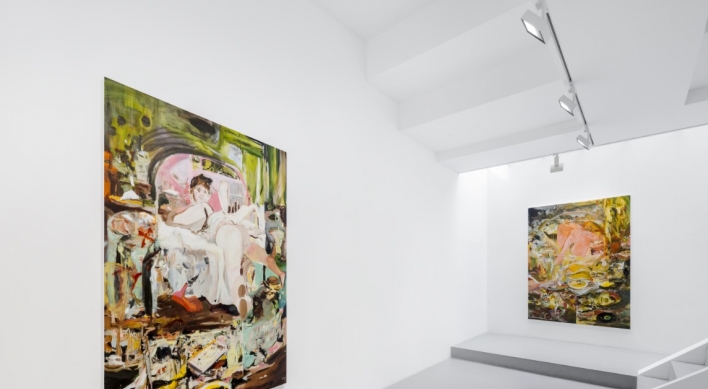
LONDON (AP) ― The art world loves hype. Works are touted as the biggest, the rarest, the most expensive.
Even in an age of superlatives, the British Museum has something special ― the oldest known figurative art in the world.
The artworks on display in the new exhibition “Ice Age Art’’ are so old that many are carved from the tusks of woolly mammoths.
But it’s not just their age that may surprise visitors. It’s their artistry.
These are artworks, not just prehistoric artifacts. Some of the sophisticated carvings, sculptures and drawings of people and animals look like something Pablo Picasso or Henry Moore might have created.
That shock of recognition is the aim of the show, which is subtitled “arrival of the modern mind’’ and explores the moment the human brain began to embrace abstraction, symbolism and imagination.
We don’t know what these distant ancestors believed or how they communicated, but we know how they thought ― like us.
“They are fully modern humans,’’ Jill Cook, the museum’s curator of Paleolithic exhibitions, said Tuesday. “What these works of art show is that they have a visual brain capable of imagination and creativity.
“They really are us. They are our ancestors.’’
Although early humans were making sophisticated tools, abstract items and music in southern Africa 100,000 years ago, the earliest surviving works representing people and animals appear after groups of people moved into eastern and central Europe some 45,000 years ago.
The plentiful wildlife roaming the grassy plains helped these communities of hunter-gatherers grow and flourish. “The living was quite easy,’’ Cook said.
Then, some 40,000 years ago, the weather took a change for the icy. Suddenly, humans were struggling for survival, and this seems to have brought a surge of creativity.
Cook said that “faced with increasingly difficult conditions, finding the courage to go on’’ required of early humans “a fixing on things outside the human,’’ ― the spiritual, perhaps.’’
From its own collection and others across Europe, the museum has gathered artworks, made between 40,000 and 10,000 years ago, that reveal a world vastly different from ours. Few are made from wood, a precious commodity during the Ice Age that had to be hoarded for fuel.
Even in an age of superlatives, the British Museum has something special ― the oldest known figurative art in the world.
The artworks on display in the new exhibition “Ice Age Art’’ are so old that many are carved from the tusks of woolly mammoths.
But it’s not just their age that may surprise visitors. It’s their artistry.
These are artworks, not just prehistoric artifacts. Some of the sophisticated carvings, sculptures and drawings of people and animals look like something Pablo Picasso or Henry Moore might have created.
That shock of recognition is the aim of the show, which is subtitled “arrival of the modern mind’’ and explores the moment the human brain began to embrace abstraction, symbolism and imagination.
We don’t know what these distant ancestors believed or how they communicated, but we know how they thought ― like us.
“They are fully modern humans,’’ Jill Cook, the museum’s curator of Paleolithic exhibitions, said Tuesday. “What these works of art show is that they have a visual brain capable of imagination and creativity.
“They really are us. They are our ancestors.’’
Although early humans were making sophisticated tools, abstract items and music in southern Africa 100,000 years ago, the earliest surviving works representing people and animals appear after groups of people moved into eastern and central Europe some 45,000 years ago.
The plentiful wildlife roaming the grassy plains helped these communities of hunter-gatherers grow and flourish. “The living was quite easy,’’ Cook said.
Then, some 40,000 years ago, the weather took a change for the icy. Suddenly, humans were struggling for survival, and this seems to have brought a surge of creativity.
Cook said that “faced with increasingly difficult conditions, finding the courage to go on’’ required of early humans “a fixing on things outside the human,’’ ― the spiritual, perhaps.’’
From its own collection and others across Europe, the museum has gathered artworks, made between 40,000 and 10,000 years ago, that reveal a world vastly different from ours. Few are made from wood, a precious commodity during the Ice Age that had to be hoarded for fuel.
-
Articles by Korea Herald





![[Herald Interview] Mom’s Touch seeks to replicate success in Japan](http://res.heraldm.com/phpwas/restmb_idxmake.php?idx=644&simg=/content/image/2024/04/29/20240429050568_0.jpg&u=)



![[News Focus] Lee tells Yoon that he has governed without political dialogue](http://res.heraldm.com/phpwas/restmb_idxmake.php?idx=644&simg=/content/image/2024/04/29/20240429050696_0.jpg&u=20240429210658)









![[Today’s K-pop] Seventeen sets sales record with best-of album](http://res.heraldm.com/phpwas/restmb_idxmake.php?idx=642&simg=/content/image/2024/04/30/20240430050818_0.jpg&u=)